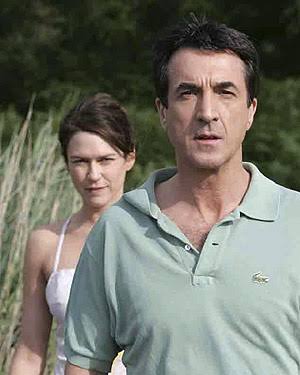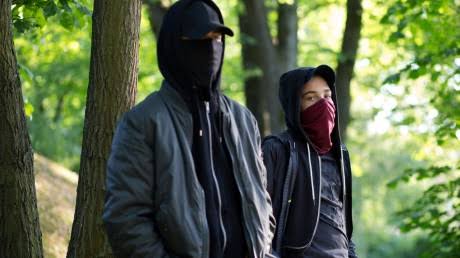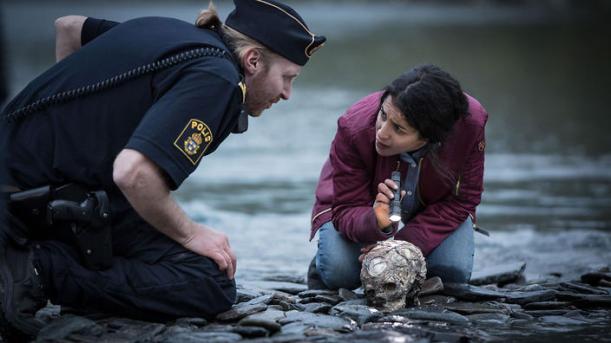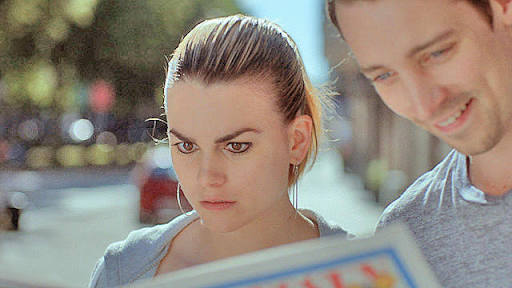
Tell No One / Ne le dis à personne – intimate times
Harlan Coben is an American crime writer whose novels include Just One Look and Tell No One. Both novels have been adapted by French filmmakers: Just One Look as Juste Un Regard, a six-part TV series (2017), and Tell No One as a film, Ne le dis à personne (2008).
In some respects the two narratives mirror each other.
In Tell No One (which I’ll refer to by its English-language title), one moment a man and his adored wife are enjoying intimate time together, then abruptly she disappears, abducted, ostensibly murdered, till a cryptic email with photo shows up eight years later suggesting the possibility she’s alive. The man pursues a trail of leads, engages in a fierce chase, to find the truth of his marriage.

Marie-Josée Croze and Francois Cluzet in Tell No One
In Just One Look (for consistency, I’ll stay English title here too), a woman and her adored husband enjoy domestic intimacy one moment, then a photo appears suddenly, and he, too, abruptly disappears, ostensibly deserting the family he loves, till a coded text arrives suggesting he’s been abducted. The woman pursues a trail of lead, engages in fierce chases, to find the truth of her marriage.

Just One Look / Juste Un Regard – Virginie Ledoyen and Thiérry Neuvic find that troubling photo
The French film adaptation of Tell No One changes Harlan Coben’s original ending. The novelist agrees the French ending is superior, and it is, but I find it amusing that both French adaptations conclude with the recognition that in both cases the wife, on the face of it a paragon, is in fact deeply, Eve-like guilty. The angel is in truth a fallen woman, no matter how sympathetically we might view her circumstances. Cherchez la femme.
It is perhaps no coincidence that the angelic wife in Juste Un Regard is named Eva; in the novel, the character had a different but also arguably symbolic name, Grace, and her married name, the name her husband carries, is ‘Lawson’ – “the law’s son”. In the TV series, the family name, the name Eva married, is ‘Beaufils’ – “beautiful son”. “Beau” (strictly speaking, ‘handsome’) is also the generic first name recruits to the French Foreign Legion traditionally take to preserve their anonymity in their incarnations as colonial military, as in ‘Beau Geste’. This is definitely not coincidence.
Both the film and the TV series are highly watchable, largely thanks to appealing casting. In Just One Look, Eva is played by the delectable Virginie Ledoyen, Everywoman as Everywoman wishes she were. Her husband is Thiérry Neuvic, who I wouldn’t trust at 20 paces. The villain-as-ally is Thiérry Fremont, a French actor also seen in the 2017 French TV series Transferts (Transfer), where he is equally brilliant – my new fave face of evil. The villain-as-villain is Jimmy Jean-Louis, a large menacing Haitian, casting I wasn’t sure about – racial stereotype? – but which works well. (The villain-ally played by red-haired Fremont is written as Chinese in the novel, by the way.)
In Tell No One, the hero is Francois Cluzet, Everyman as Every French Man wishes he were, and the missing wife is an elegant Marie-Josée Croze. (A hitman who in the novel is male and Chinese is in the film female and apparently butch.)

Virginie Ledoyen and Thiérry Neuvic again, still. Would you trust that man as a husband?
Both films had central premises that made me laugh, an entertained, indulgent laugh. In Just One Look, the plot hinges on a commercial dispute (I’m trying to write that spoiler-free – the nature of the dispute is one I am all too familiar with in my personal history, but which rarely surfaces as the basis for a crime mystery.)
In Tell No One, the plot depends on accepting that husband and wife had been childhood sweethearts, from their first kiss, at primary school age; that there never was or could be anyone else, for either of them; and that after eight years, with his wife’s body ostensibly identified and buried, the husband was still in perpetual mourning.
I’ve known a few French men. I like them very much. I get that the French are romantic and sentimental. It is also the case, without wishing to plunge too far into national stereotypes, that the French men I have known are entirely capable of being romantically in love with one woman while concurrently sexually involved with other women. But that would make for a very different film.

Francois Cluzet. Chasing the truth.














